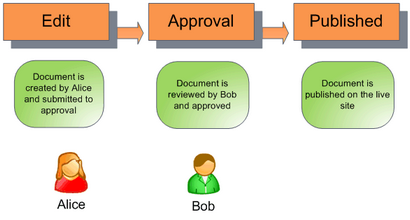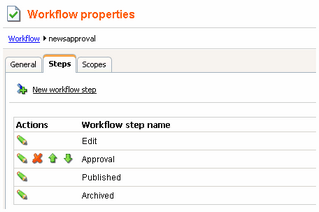Workflow settings can be managed in Site Manager -> Development -> Workflows.
The workflow you create in this chapter will be used for all examples in the next chapters. It will look like this:
| • | Any editor can create a news item in the /News section of the web site. |
| • | Then, the news item must be approved by one of the members of the role PR Managers. The users authorized to approve the document in the given step are also authorized to modify the document in the given step. |
| • | Approved news item is published on the web site. |

Creating testing users and roles
Before we configure the workflow, we will create testing users. Go to Site Manager -> Administration -> Users and click New user. Create a new user with following details:
| • | User name: Alice |
| • | Full name: Alice Murphy |
| • | E-mail: <your e-mail> |
| • | Enabled: yes |
| • | Is editor: yes |
Go to the Sites tab and assign the user to the appropriate web site.
Go to the Roles tab and assign the user to the CMS Editors role of the given web site.
Create another user with following details:
| • | User name: Bob |
| • | Full name: Bob Johnson |
| • | E-mail: <your e-mail - you may want to use a different e-mail> |
| • | Enabled: yes |
| • | Is editor: yes |
Go to the Sites tab and assign the user to the appropriate web site.
Go to the Roles tab and assign the user to the CMS Editors role of the given web site.
Go to Site Manager -> Administration -> Roles, choose the appropriate site from the top drop-down-list and click New role. Enter the following details:
| • | Role display name: PR Managers |
| • | Role code name: PRManagers |
Switch to the Users tab and add user Bob Johnson to this role.
As you can see, Alice is the news editor (because of the CMS Editors role) and Bob is the PR Manager who will approve the news (PR Managers role) and can also edit the news (CMS Editors role).
|
Please note
The PR Managers role has no permissions set for the purpose of this example. This means that if a user was a member of only this particular role, she would not be able to perform a full range of tasks such as creating, editing or deleting documents, etc. In your real website, you would probably want to go to Site Manager -> Administration -> Permissions and give the user role appropriate permissions, especially those for Module CMS Content.
See also chapter Permissions for modules and documents for detailed information on how to do this. |
Defining a new workflow
Go to Site Manager -> Development -> Workflows, click New workflow and enter the following values:
| • | Display name: News approval |
| • | Code name: newsapproval |
Click OK to create the workflow.
Defining workflow steps
Choose the Steps tab and create a new workflow step:
| • | Display name: Approval |
| • | Code name: Approval |
Click OK and choose the Roles tab in the Workflow properties dialog. Choose the appropriate web site in the drop-down list and select the PR Managers role and click OK. Now the PR Managers are authorized to edit, approve and reject documents in the newly created step.
When you see the list of workflow steps now, it looks like this:

As you can see there are always three default steps:
| • | Edit - the first step when the document is created or modified after it was published. |
| • | Published - the document is published on the live site. When you edit such a document, it's automatically moved to step Edit. |
| • | Archived - the document is not published on the live site, but it remains in the content repository. |
As you can see, the custom steps are placed between the Edit and Published steps. You can change the order of the steps using the up/down arrows (if there's more than one custom step).
Defining workflow scope
The workflow scope defines which documents the workflow should be applied to. Switch to the Scopes tab, choose the appropriate web site from the drop-down list and click New workflow scope. Enter the following details:
| • | Starting alias path: /news (this is the section of the web site for which the workflow will be applied) |
| • | Document type: News |
| • | Culture: (all) |
Click OK.
We have configured the workflow process for the news documents. In the next chapter, you will learn how the workflow works in our sample scenario.
